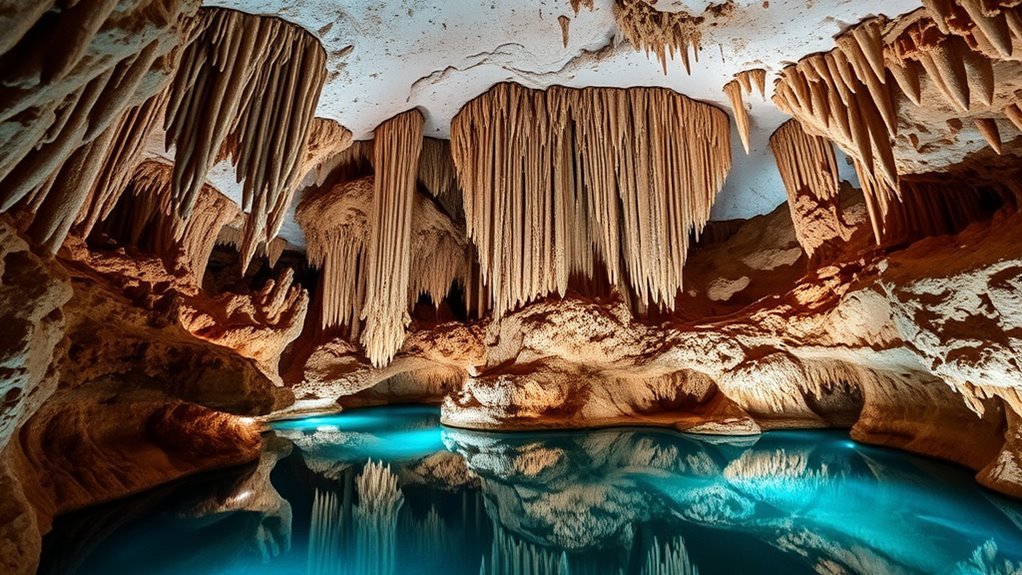You’ve likely heard of Luray Caverns, but do you know its historical significance? This natural wonder, discovered in 1878, is more than just a tourist attraction; it represents both geological marvels and cultural heritage. Imagine walking through formations that took millions of years to sculpt and learning about artifacts that tell stories of the past. There’s so much more beneath the surface, just waiting for you to uncover.
Key Takeaways
- Discovered in 1878, Luray Caverns revealed significant archaeological finds, including a 500-year-old Native American skeleton.
- Ownership disputes following the discovery highlight its historical and legal importance in the late 19th century.
- The Great Stalacpipe Organ, added in 1954, showcases the fusion of natural wonder and cultural innovation.
- Geological formations from the Lower Ordovician period emphasize the caverns’ geological significance.
- Designated as a National Natural Landmark, Luray Caverns is a major site for geological and historical education.
Discovery and Early Exploration
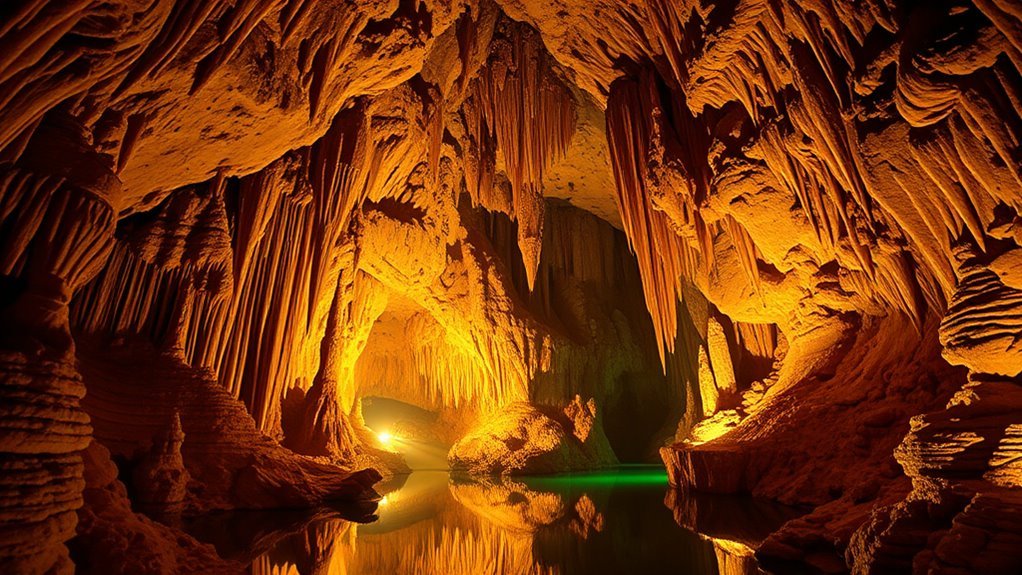
When Andrew Campbell, William Campbell, and Benton Stebbins stumbled upon a limestone sinkhole on August 13, 1878, they couldn’t have imagined the historical treasure they were about to uncover.
Luray Caverns was discovered, and explorations began immediately thereafter. Andrew, his companions, and his nephew Quint descended into the cave after four hours of digging. There, they found the Washington Column, an impressive formation that marked the beginning of this cavern’s historical significance.
Among the artifacts uncovered were bone fragments and the skeleton of a Native American girl, estimated to be around 500 years old. These findings highlighted the site’s rich past.
However, ownership disputes soon arose until 1881, when the property was sold to The Luray Cave and Hotel Company.
Legal Disputes and Ownership Changes
Though the discovery of Luray Caverns promised excitement and intrigue, it also sparked significant legal disputes over its ownership. After its discovery in 1878, the property was initially owned by Sam Buracker, who sold it at a court-ordered auction.
Andrew Campbell and others secretly purchased the cave tract, leading to legal battles over rightful ownership that lasted until 1881. Eventually, Luray Caverns was sold to The Luray Cave and Hotel Company, which later became the Luray Caverns Company in 1893.
These legal disputes marked a pivotal chapter in the caverns’ history, highlighting the challenges of ownership and the value of preservation. Today, the Graves family owns Luray Caverns, committed to preserving its natural beauty and historical significance.
Development and Commercialization
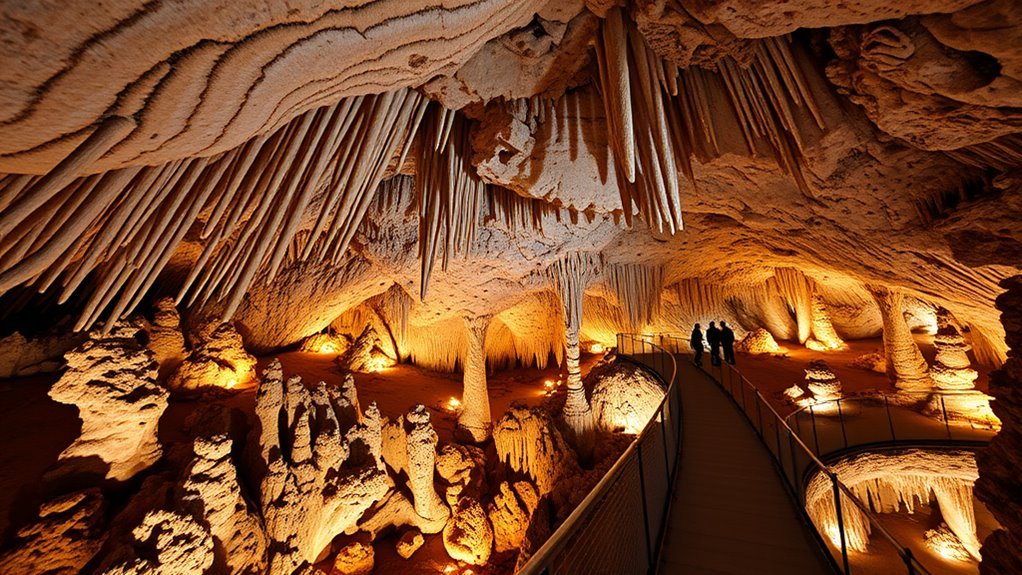
As you explore the development and commercialization of Luray Caverns, you’ll notice how resolving legal disputes paved the way for significant enhancements.
T.C. Northcott’s vision transformed the caverns into a visitor-friendly attraction, culminating in unique additions like the Great Stalacpipe Organ and the Car and Carriage Caravan Museum.
These developments not only boosted tourism but also underscored the caverns’ status as a Registered Natural Landmark.
Legal Disputes Resolved
Ownership of Luray Caverns was fiercely contested after its discovery in 1878, leading to a two-year legal battle that concluded in 1881.
Initially owned by Sam Buracker, the land’s ownership was debated until a court-ordered auction allowed Andrew Campbell and others to purchase the cave tract.
After extensive legal disputes, the property was sold to The Luray Cave and Hotel Company and later acquired by the Luray Caverns Company in 1893.
These resolutions paved the way for commercialization, opening Luray to the public and drawing 18,000 visitors by 1906.
The establishment of the Luray Caverns Corporation in 1905 marked a significant milestone, ensuring proper management and development of the caverns as a popular destination.
Tourist Attractions Added
The transformation of Luray Caverns into a premier tourist destination began with several key additions that have captivated visitors over the years.
In 1954, the Great Stalacpipe Organ, the world’s largest musical instrument, was invented by Leland W. Sprinkle, turning the underground into a harmonious wonder.
You’ll find that paved walkways replaced wooden planks by 1950, enhancing accessibility for all visitors.
The Car and Carriage Caravan Museum, opened in 1957, enriches your experience by showcasing 140 pieces of transportation history.
In 2009, the Shenandoah Heritage Village was established, displaying 19th-century structures that celebrate historical significance.
These tourist attractions collectively enhance your visit to Luray Caverns, offering a blend of music, history, and improved visitor experience.
Geological Features and Speleothem Formation
Nestled in the dolomites of the lower Beekmantown Dolomite, Luray Caverns boasts a fascinating array of geological features that date back to the Lower Ordovician period.
You’ll find an impressive collection of speleothems, including stalactites and stalagmites, formed from calcium carbonate. As water drips through the caverns, it loses carbon dioxide, resulting in the precipitation of calcium carbonate, also known as lime. This process is ongoing, with new deposits forming at about one cubic inch every 120 years.
The vibrant colors you see are due to the high iron content, adding a unique charm to these formations.
- Constant 54°F (12°C) temperature supports speleothem growth
- Karst features include intriguing sinkholes
- Luray Caverns’ formations showcase nature’s artistry
Cultural and Educational Impact
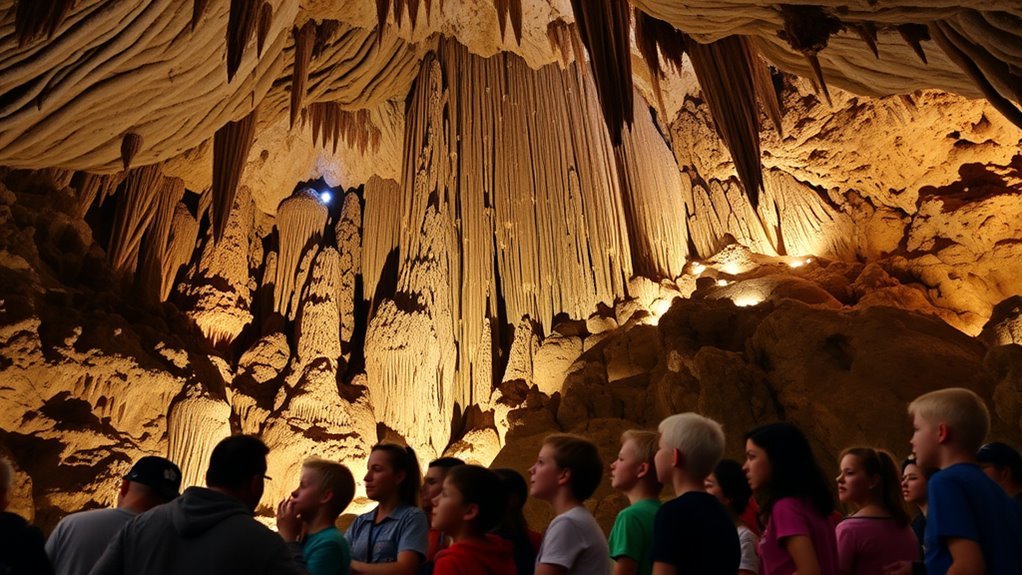
When you visit Luray Caverns, you experience an educational journey through guided tours that illuminate both its historical and geological significance.
You’ll gain insights into how these natural formations came to be, while the Great Stalacpipe Organ offers a unique blend of cultural heritage by turning rock formations into musical instruments.
Educational Tourism Opportunities
As you explore the Luray Caverns, you’re not just witnessing natural beauty but engaging in a unique educational experience.
These caverns, a Registered Natural Landmark, are ideal for educational tourism, showcasing stunning geological formations and offering insight into the field of speleology.
Guided tours, such as the historic Discovery Tour, provide an in-depth look into the caverns’ history and the local area’s historical context.
You’ll find the Great Stalacpipe Organ fascinating, a highlight for those interested in geology and acoustics.
The Car & Carriage Caravan Museum complements your visit by adding cultural and historical depth to your learning experience.
Environmental science enthusiasts will appreciate the caverns as a living laboratory.
- Explore the majestic geological formations
- Discover the intriguing Great Stalacpipe Organ
- Immerse in historical context at on-site museums
Geological Insights Provided
While exploring the educational opportunities at Luray Caverns, you gain valuable geological insights that enrich your understanding of both culture and science.
Luray Caverns, a Registered Natural Landmark since 1974, showcases geological formations such as stalactites and stalagmites, which are formed by the precipitation of calcium carbonate. This process provides a glimpse into the geological processes that have shaped cave ecosystems over the centuries.
With a constant temperature of 54°F and high humidity, the caverns create an ideal environment for these formations to grow—at a rate of one cubic inch every 120 years.
The discovery of artifacts, such as bone fragments and a 500-year-old Native American skeleton, further underscores the cultural significance of Luray Caverns, blending human history with natural wonders.
Cultural Heritage Preservation
Although Luray Caverns is renowned for its stunning geological features, its efforts to preserve cultural heritage are equally impressive and impactful.
As a Registered Natural Landmark, the caverns not only highlight their geological significance but also serve as a rich educational resource. You’ll discover artifacts, such as Native American remains, that offer valuable insights into the early inhabitants of the area.
The Shenandoah Heritage Village, established in 2009, showcases 19th-century structures, emphasizing the importance of preservation.
Educational experiences at the Car & Carriage Caravan Museum and Toy Town Junction immerse you in the region’s transportation history and childhood nostalgia.
- Learn about the cultural heritage through Native American artifacts.
- Explore the Shenandoah Heritage Village for a glimpse into the past.
- Plunge into transportation history at the Car & Carriage Caravan Museum.
Modern Attractions and Visitor Experience
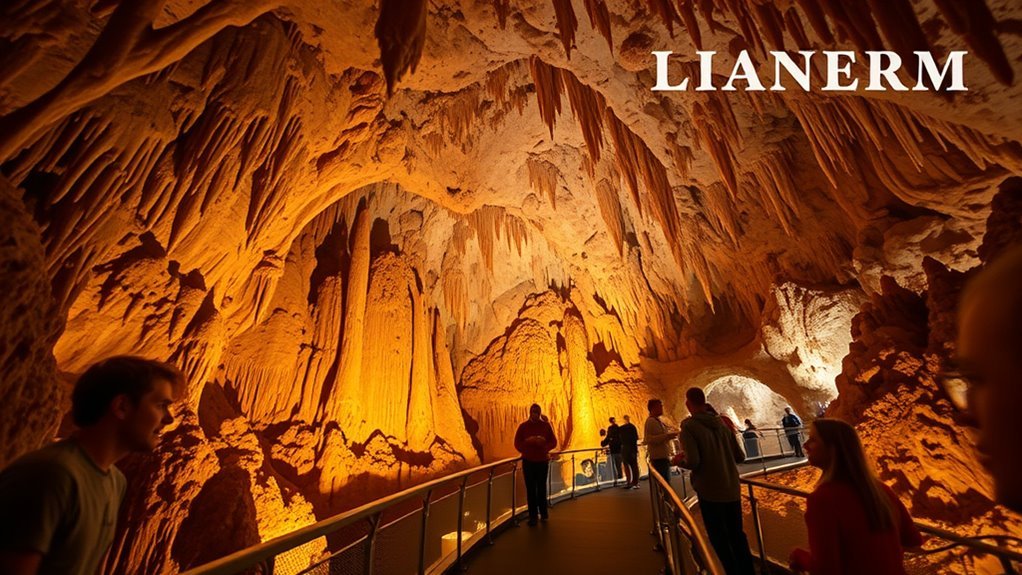
Ever wonder what makes Luray Caverns such an enchanting destination for modern explorers? It’s the blend of modern attractions and a unique visitor experience. As you traverse the 1.5-mile path, you’re mesmerized by stunning formations. Guided tours offer insights into the cavern’s historical significance. Don’t miss the Car & Carriage Caravan Museum, where antique vehicles add charm and character. The Great Stalacpipe Organ plays melodies through stalactites, creating a memorable auditory experience: seasonal events and the Gem Sluice offer fun and engaging activities for all ages.
| Attraction | Experience Type | Unique Feature |
|---|---|---|
| Luray Caverns | Guided Tour | Stunning Formations |
| Car & Carriage Caravan Museum | Exhibit | Antique Vehicles |
| Great Stalacpipe Organ | Musical Experience | Plays Through Stalactites |
| Seasonal Events | Interactive Activities | Historic Twists |
| Gem Sluice | Hands-On Experience | Gem Discovery |
Luray Caverns in Popular Culture
In popular culture, Luray Caverns has left a significant mark, inspiring creators across various media. The 2008 video game Fallout 3 features Lamplight Caverns, influenced by Luray’s stunning geological formations. Developers acknowledged that this natural landmark inspired the immersive environments within the game, which reflected real-world cave systems.
Luray Caverns has been a muse for artists and photographers, capturing its unique beauty and embedding it further in popular culture. Its status as a National Natural Landmark ensures its inclusion in educational materials and documentaries, which focus on natural wonders and geological phenomena. These representations highlight its ongoing influence and significance.
- Fallout 3’s immersive environments: Inspired by Luray Caverns.
- Artists and photographers are drawn to its unique formations.
- Educational materials and documentaries: Feature it as a natural wonder.
Conclusion
In visiting Luray Caverns, you’ll step into a world where history and nature intertwine. The discovery and development of the caverns tell a story of exploration and transformation, while the stunning geological formations captivate the imagination. As you explore, you’ll appreciate the cultural treasures unearthed here, deepening your understanding of our shared heritage. Luray Caverns isn’t just a tourist spot; it’s an educational journey that enriches your connection to natural history and the wonders beneath our feet.
FAQs
1. What Is the Historical Significance of Caves?
You explore caves to uncover their historical significance. They reveal ancient human activities, serve as cultural landmarks, and offer insights into past civilizations. Their unique ecosystems and archaeological finds deepen your understanding of Earth’s history and evolution.
2. What Is the History of Luray?
You discover Luray’s rich history, starting with its 1878 discovery by Andrew Campbell. Feel the legal battles, ownership changes, and T.C. Northcott’s innovations, all shaping today’s popular tourist destination with ongoing family care and preservation.
3. Are There Human Remains in Luray Caverns?
Yes, human remains can be found in Luray Caverns. The skeleton of a Native American girl was discovered, indicating the presence of ancient humans. These findings demonstrate the historical value of the caverns and offer insights into early human activity.
4. What Is the History of the Shenandoah Caverns?
Would you like to learn about the history of Shenandoah Caverns? They were discovered in 1884 by two boys exploring a quarry. Since then, they’ve become famous for their stunning formations and vibrant colors, enchanting visitors.
